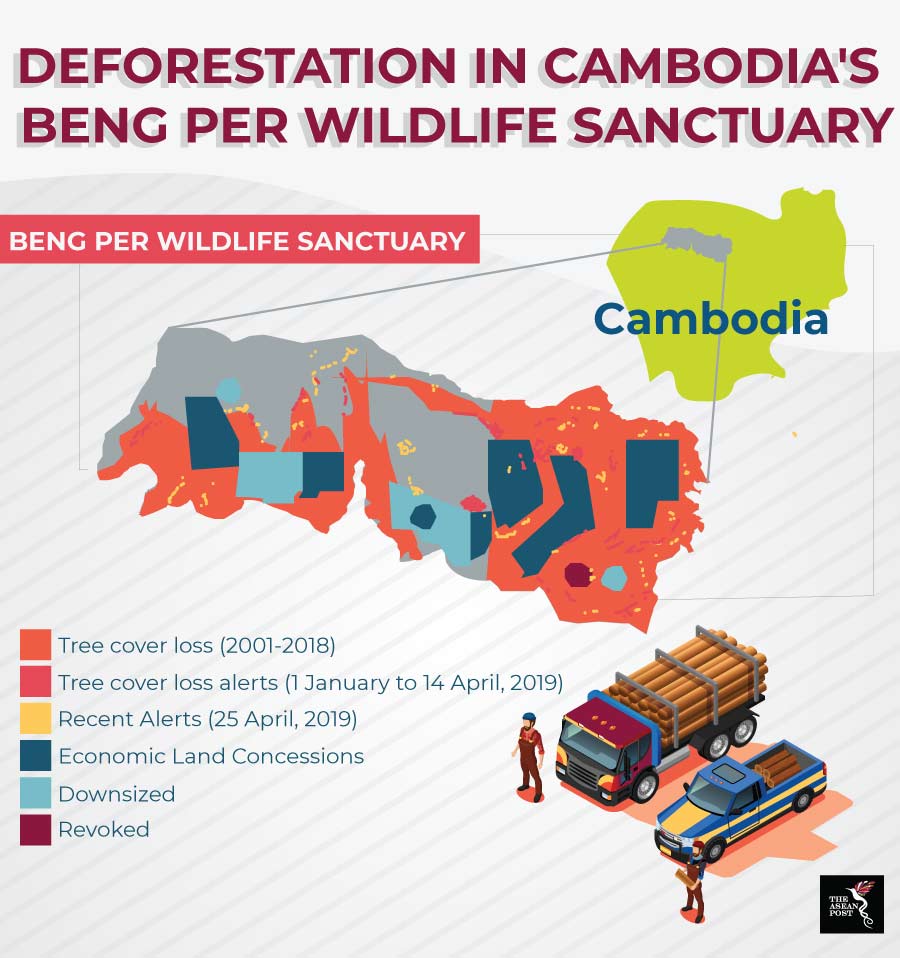Cambodia’s Beng Per Wildlife Sanctuary is symbolic of the country’s poor forestry management. Around 2,000 square kilometres (sq km) – around three times the size of Singapore – is lost to illegal logging in Cambodia every year where wildlife sanctuaries – despite their name – are not spared.
When first established in 1993, the Beng Per Wildlife Sanctuary located five hours north of the Cambodian capital of Phnom Penh covered 2,425 sq km. Only 1,990 sq km remained by 2000, and by last year, that number was down to 970 sq km.
Cambodia has one of the worst deforestation rates in the world, and the country's primary rainforest cover went from over 70 percent in 1970 to just three percent today. Cambodia's deforestation has been accelerating over the past decade due to industrial plantation expansion, logging and agriculture – and the Beng Per Wildlife Sanctuary is the latest protected area to fall victim to illegal logging.
Although forests still cover a sizable percentage of Cambodia, and other countries have lost more area, it is the rate of deforestation that is worrying. Despite being declared as a protected wildlife area, around 100 sq km of forest cover was cleared in the Prey Lang forest in 2016 – an area which cuts across four Cambodian provinces. Satellite imagery from the University of Maryland showed forest loss of 56 sq km in Prey Lang in 2017, or around 21 football fields per day.
Cambodia’s controversial economic land concessions (ELCs) which began in 1996 allowed for land – even in protected areas – to be cleared for agriculture and logging. While the policy was stopped in 2012, rampant corruption means that officials close one eye to the harvesting and smuggling of illegal timber – mostly to China and Vietnam – with this rapid deforestation threatening Cambodia’s economy, food security and biodiversity.
Apart from destroying biodiversity, creating landslides and worsening floods, deforestation risks the livelihoods of communities which depend on forests for food, medicine and fuel. Forests also play a vital cultural and religious role, and with 75 percent of Cambodians living in rural areas and depending on forest resources, it becomes evident why deforestation is such a big problem in Cambodia.

Rubber and rosewood
The demand for rubber and rosewood, both largely driven by China, are the main industries fuelling Cambodian deforestation.
Cambodia’s Ministry of Agriculture, Forestry, and Fisheries reported that rubber production increased by 32 percent in the first quarter of 2019. The 48,778 tonnes of rubber produced from January to March marked an increase of 11,753 tonnes compared to the same period in 2018 – with most of it destined for the export market. With total rubber tree plantations in Cambodia currently standing at 4,363.57 sq km, the kingdom exported 217,500 tonnes of dry rubber last year – which was an increase of about 15 percent compared to 2017.
Prices for rosewood, which is highly sought after in China and Vietnam to make luxury furniture, can reach up to US$80,000 per tonne. A ban on the trade and harvest of Siamese rosewood was made under the Convention on International Trade in Endangered Species (CITES) in 2013 which soon led to a thriving black market.
The UK-based Environmental Investigation Agency (EIA) identified the trade of illegal timber from Cambodia into Vietnam as one of the principle reasons for illegal logging in Cambodia in recent years. Last year the EIA released results of a probe into illegal logging and smuggling which found that since November 2016, more than 300,000 cubic metres of timber was harvested in a wildlife sanctuary and two protected areas in Cambodia – where officials reportedly made at least US$13 million in bribes from Vietnamese timber traders.
Until this culture of kickbacks is eliminated and Cambodians find a more sustainable way to exploit their natural resources, deforestation will remain a key issue for the kingdom.
Related articles:
Deforestation – a modern-day plague in Southeast Asia
